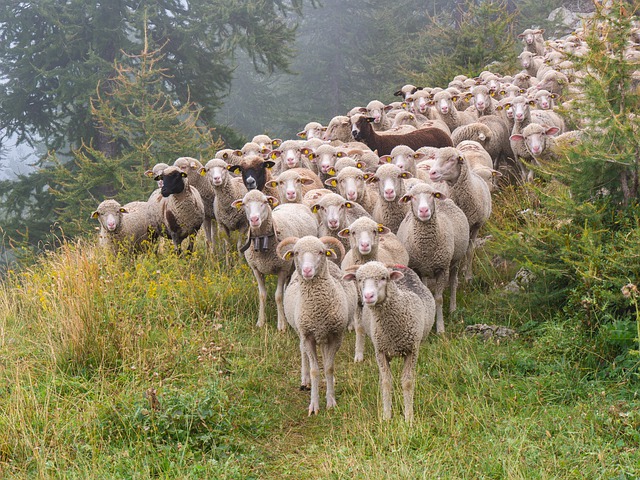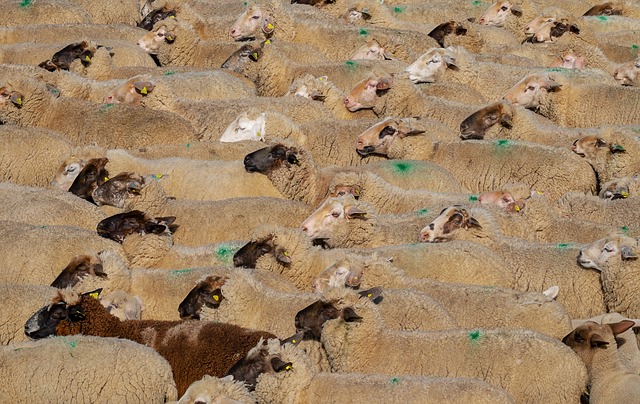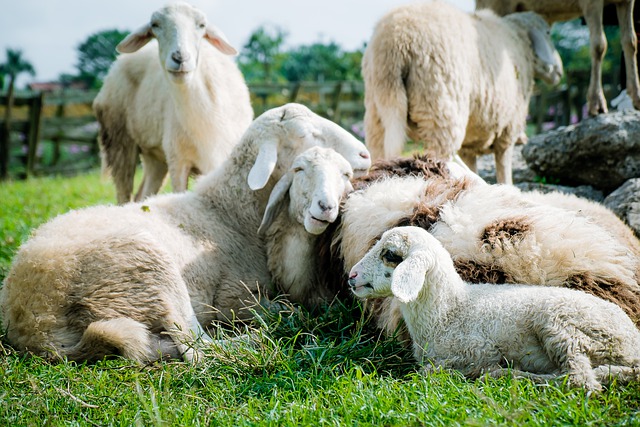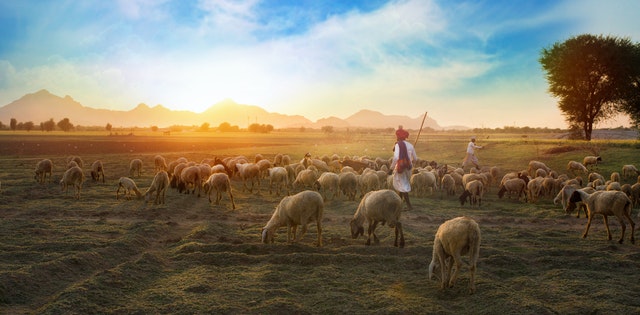After cow, goat, and buffalo, sheep farming is considered everywhere at the rural farmer level as it helps in improving the socio-economic and nutritional status of the common man in our country. The nutritional value and taste of lamb mutton are almost identical to that of goat meat. The sheep can only live on by eating hey grass and leaves. If some granular food is provided to them then the farmers can get a good production. Sheep are raised for wool and meat. A special feature of sheep is that they do not need much manpower to farm as they prefer to stay with the cows in groups.
#What Is Sheep Farming?
Sheep farming is the process of rearing sheep for profitable business purposes. The farmers are rearing these animals for wool and meat purpose. The government’s livestock department is also encouraging people to do sheep farming in India. Although that initiative is not enough. This is because it is a scheme to distribute free sheep among some families and to do cattle farming commercially usually referring to cows, goats, and chickens. But these special farms require a large amount of capital. The accommodation, food, and medical management of these animals are quite expensive. For these reasons, especially the poor people of the country are leaning towards sheep farms as they are less costly and more profitable.

#Specific Features Of Sheep:
- As a special feature of sheep, they prefer to stay in groups. As a result, it is very convenient to keep sheep, especially in pastures, because it is grouped and does not require many people to control the flock.
- Besides, the sheep can procure their own food. The initial cost of raising sheep is relatively low. Sheep become pregnant six months in a row, giving birth to more than one calf at a time. As a result, the number of sheep increases rapidly, sheep excrement is used as land manure, weeds of the land are benefited, grass can be fed in water bodies and sheep diseases are very rare.
- Fur is obtained from sheep which can make extra income by selling in the market. An adult sheep produces 3.5-5.5 kg of fur every year. Sheep wool can be cut 3-4 times a year. 0.5-0.75 kg of wool is available at a time. As the fur is thick and hollow, low quality blankets are made from it. Electric fur trimmers are now available in the market to save extra money for fur cutting.
- Raising domestic sheep is the least risky for small farmers. Domestic sheep give birth to 2-3 kids at a time. Compared to that, other breed sheep gives 1-2 kids. However, the Shankar breed is larger in size and weight. About twice as much meat is obtained from the sheep of the same age as from the domestic sheep.
#Sheep Farming Management:
1. Housing Management:
The first and foremost basic need of every living thing is a comfortable habitat. The reason for the death of sheep in our country is a lack of housing or unhealthy housing. Most of the farmers do not have good houses to keep their sheep. Moreover, farmers with more than 20/30 sheep do not have healthy housing for their sheep. In most cases, family-raised sheep are kept in a small shed under a farmer’s house or under a stool, where light and air are less likely to enter. But healthy housing for sheep can be built at little cost. One thing to keep in mind while constructing a goat or sheep shelter is to keep the sheep on the scaffolding or slats without leaving the sheep on the floor.
2. Food Management:
Sheep eat everything. Sheep are omnivorous animals. It eats everything from dry hay to the leftovers of cow feed. So the cost of food for keeping sheep is less. The sheep is a herbivorous mammal. Sheep usually prefer to graze and start eating from the bottom of the grass, not the head of a tree or the tip of a grass-like goat. Like other ruminants of sheep, the four-chambered digestive system and sheep fiber can easily convert food, herbs, etc. into common sugars. In addition, sheep eat dry hay and hay in both normal and unfavorable conditions. In our country, there is not enough food to feed the sheep. Moreover, keeping sheep in a confined manner is a rare occurrence even at present.
3. Sheep Caring:
This animal should be appropriately focused on keeping them solid, enthusiastic, and practical and getting better returns from them. Sheep hide ought to be cleaned with an ordinary brush. This will get the earth out of the hide. Outer parasites ought to be applied to the sheep now and again. The sheep ought to be washed prior to cutting. Sheep farming in Karnataka develops with this caring management.
4. Quality Breeding:
Sheep are called seasonal breeders although some sheep breed throughout the year. Sheep usually breed at 6-8 months (reach sexual maturity) and male sheep reach sexual maturity at 4-6 weeks of age. However, differences in age are observed by caste. It is not advisable to raise a sheep until it has gained proper body weight. Infant mortality from low birth weight lambs is high and good service is not available after mating. The reproduction needs extra care.
5. Lamb Care and Food Management:
It goes without saying that there are no planned commercial sheep farms in our country. Sheep are kept at the family level. It has been observed at the field level that the biggest problem in raising sheep in this way is the high mortality rate of lambs. The cause of death has been found to be prenatal malnutrition and malnutrition.
Moreover, after the delivery of the baby, the mother takes the baby to the field with the sheep. The physically weak child was severely disturbed and died as the mother roamed the field with the wolf all day. Therefore, the mother should be kept separate from the lamb for some time until she is able to bear the stress after delivery. The baby should be fed milk since the mother does not get the required amount of milk.
6. Disease Management:
The biggest way to prevent infectious diseases on a sheep farm is to take care of the lambs. If taken care of properly after childbirth, the disease will not be a plague. The result is not to be financially damaged. Sheep ought to be kept in a spotless and sterile climate. Sheep, everything being equal, ought to be consistently dewormed and inoculated on schedule. These animals are more helpless to rain, seizures, mastitis, foot infection, dermatitis, worms, parasites, and so on infected sheep ought to be offered clinical treatment according to the guidance of the veterinarian. Sheep farming in Telangana develops as the farmers from there provide proper treatment of sheep.

#Advantages:
- Sheep have low cost of food, little space to keep and low initial investment, so farmers who have only houses can easily raise 5-10 sheep. Sheep rearing costs less than raising any animal.
- It likes to live in group so if one wants to raise sheep on a commercial basis then one person can easily control 100-150 sheep.
- These animals are more adaptive than goats so they can adapt to any hostile environment. It can be reared together with herds of cattle.
- Sheep farming can be a good source of income for landless farmers, marginal farmers and women and unemployed people as they consume very low quality food and turn it into high value protein.
- Sheep meat is relatively soft, juicy and odorless and easy to digest as the meat is thin.
- Gives birth twice a year and gives birth to minimum 2 babies per delivery so the number increases rapidly in less time.
- Sheep are more resistant to disease.
- Raising sheep not only provides meat, but also fur and leather for making high quality warm clothes.
#Disadvantages:
- Lack of knowledge about sheep rearing.
- Very ack of interest in sheep rearing is one of the obstacles in the way of increasing sheep production in this country.
- Lack of proper idea about sheep food, shelter and health management.
- Due to non-rearing of high productive sheep in this country, the quality of their fur is also low.
- Locally reared sheep are not of good quality and their fur is not of good quality.
- There is a lack of training for farmers in this farming.
- Sheep rearing depends on regional climate, ambient conditions and low cost and easy-to-obtain food.

#Sheep Farming Business Plan:
People in rural areas are turning to sheep farming as it is cheaper and more profitable. Due to the low cost of rearing this animal and the incidence of diseases compared to other animals, there is a huge potential for commercial sheep farming in India. There is an opportunity to get rid of unemployment or self-employment by setting up a sheep farm. The rising of the Indian breed of Gaddi sheep is very profitable.
The cost is low but the profit is high. The demand for its meat is huge due to its high taste and nutritional value. If there are more commercial farms in the country, it will be possible to export meat by meeting the demand. If you want to know the sheep farming business plan in Karnataka then must read this post. This land really increases the farming business of sheep. So you can follow some tips to develop your farming business:
- Follow the scientific and modern farming methods o get more profit.
- Selection of sheep is very important to get profit in this farming. Besides the farmers should also take care, manage the house, cares of diseases, weaning etc are very crucial to get profit in sheep farming.
- The farmers need to select healthy sheep breed and taking care of them.
- Marketing plan is also important to make profit in this business.
- Before starting sheep farming business the farmers need to gain knowledge about sheep rearing management and connect with good physiotherapist.
Conclusion:
The farmers in India can change their luck with this profitable business and farming ideas. Also, the government tries to provide proper training among the farmers so that they can commercially do sheep farming in India.
